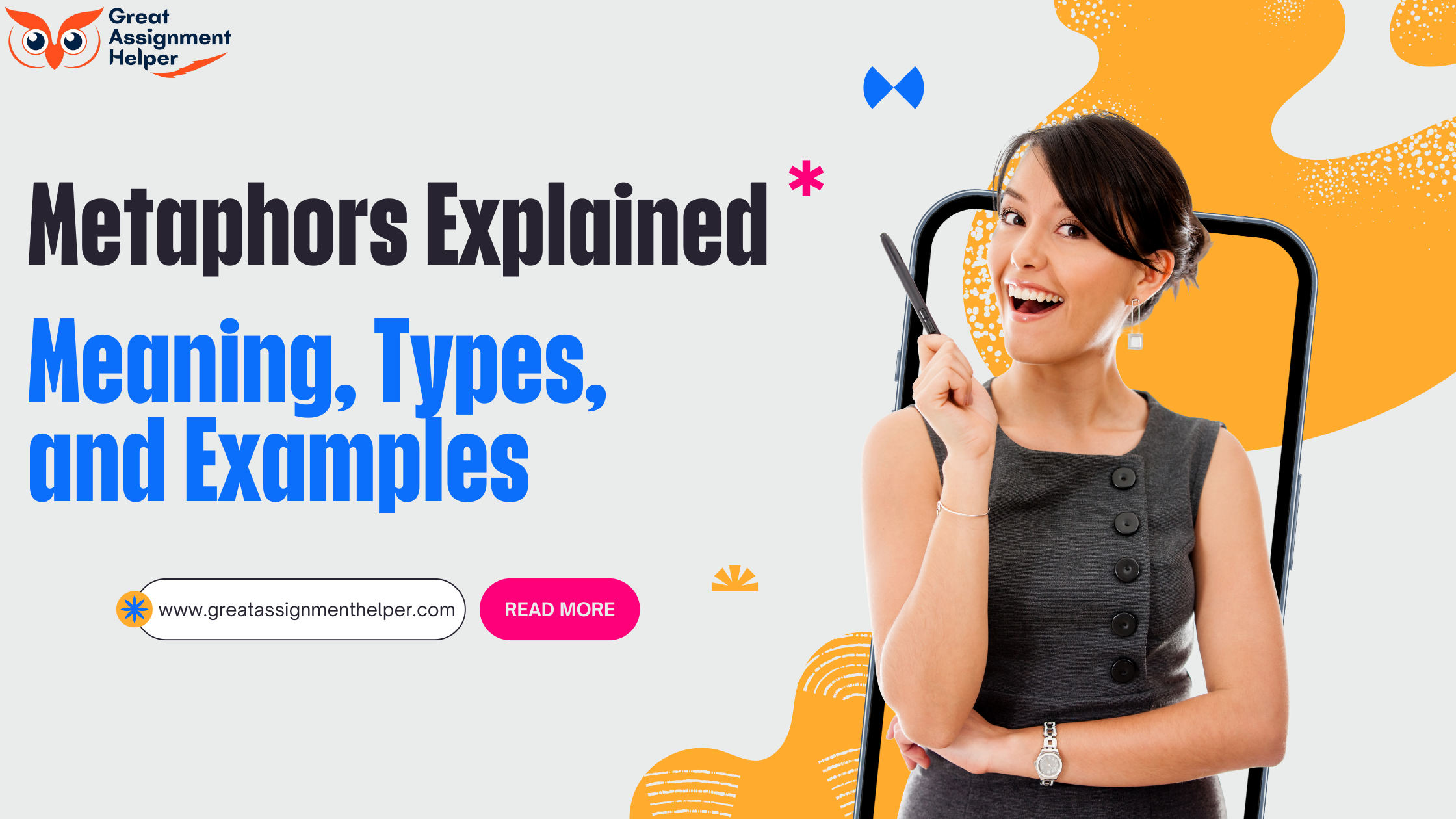
Metaphors are everywhere—used in everyday speech, literature, advertising, and even business presentations. They are not just stylistic flourishes but powerful tools for communication and understanding.
This blog will explore everything from the meaning of a metaphor to its various types, usage, and importance. We’ll also answer common queries like “What is the meaning of metaphor and examples?”,
“What is a medafore?”, and even touch on alternate spellings like "metaphore" or "metophore." Let’s dive into the world of metaphors with clarity and simplicity.
Listen To This Blog
What Is the Meaning of a Metaphor?
A metaphor is a figure of speech that compares two unrelated things by stating that one thing is another. It doesn’t use words like “as” or “like” (which would be a simile) but makes a direct comparison to draw parallels in meaning.
Example:
This doesn’t mean life is literally a rollercoaster. Instead, it highlights life’s ups and downs.
In essence, metaphors work by transferring meaning from one object or idea to another, creating vivid imagery and a deeper understanding.
Simple Meaning of Metaphor
If you're looking for a simple definition for metaphor, here it is: A metaphor is a way of describing something by saying it is something else, even though it's not literally true.
Think of it as a shortcut for meaning. Instead of explaining something in detail, you use a metaphor to express it creatively and quickly.
What Is the Meaning of a Metaphor and Examples?
The metaphors meaning becomes clearer with more examples. Here are a few commonly used ones:
He has a heart of stone.
Suggests the person is emotionally cold.
Time is money
Emphasizes the value of time in economic terms.
The classroom was a zoo.
Describes a noisy and chaotic classroom.
These comparisons enhance how we understand and feel about certain situations.
What Do Metaphors Do?
Metaphors serve various essential roles in communication and creativity:
Simplify Complex Ideas
They make abstract concepts more tangible. Saying “The brain is a computer” makes the idea of brain function more relatable.
Create Vivid Imagery
Writers use metaphors to paint pictures with words. “The sun was a golden coin in the sky” is more expressive than just saying "The sun was bright."
Add Emotional Impact
Metaphors evoke emotion, making messages more powerful. “My heart shattered into a million pieces” conveys grief more effectively than just saying "I was sad."
What's a Metaphor in Literature?
In literature, metaphors are used to add depth and beauty to storytelling. They can set the tone, reveal character traits, and emphasize themes.
Example from Shakespeare:
All the world’s a stage, and all the men and women merely players.
This extended metaphor compares the world to a stage and people to actors, offering insight into life’s transience and roles.
What Is a Metaphor and an Example?
Let’s revisit the core question: What is a metaphor and an example?
Answer:
- Definition: A metaphor is a way of saying one thing is another to highlight similarities.
- Example: “He’s a walking encyclopedia.” – Suggests that the person knows a lot.
Metaphor Easy Definition for Beginners
If you're new to metaphors, here's an even easier metaphor definition: A metaphor says something is something else, even when it's not, to help explain or illustrate an idea.
You don’t need to be a poet to understand metaphors—they are used in daily speech and advertising all the time.
What Is a Medafore?
You may have come across the term “medafore.” This is a common misspelling of “metaphor.” Despite the spelling error, the intent is usually clear, and it refers to the same concept we've been discussing.
What Is a Metaphore?
Like “medafore,” "metaphore" is another misspelling of “metaphor.” Remember, the correct spelling is metaphor—without the "e" at the end.
Types of Metaphors with Examples
Metaphors come in various forms, each serving different purposes. Let’s explore the major types:
Standard Metaphor
A simple comparison that links two ideas.
Implied Metaphor
The comparison is not directly stated but implied.
Extended Metaphor
A metaphor that stretches across multiple lines or paragraphs.
- A poem comparing love to a journey might use the metaphor throughout.
Mixed Metaphor
Combines two inconsistent metaphors, often humorously.
“We’ll burn that bridge when we get to it.”
Dead Metaphor
A metaphor so commonly used it has lost its impact.
- “Foot of the bed.”
Metaphors Meaning in Different Contexts
In Psychology:
Metaphors help us understand emotions and thoughts.
For example, "baggage" in a psychological context refers to emotional burden.
In Advertising:
Metaphors are used to create memorable slogans: “Red Bull gives you wings.” (Suggesting energy and uplift)
In Music:
Lyrics are full of metaphors:
“You are my sunshine.” – Suggests warmth, comfort, and happiness.
Why Are Metaphors Important?
Metaphors are more than stylistic choices. They shape how we perceive the world.
Cognitive Benefits
Help in understanding abstract ideas.
Creative Thinking:
Open new ways of seeing relationships.
Communication
Make speech more engaging and persuasive.
Metophore: Another Common Misspelling
Like “medafore” and “metaphore,” “metophore” is a typographical error for metaphor. All of these incorrect spellings still point back to the same literary device.
What Is the Definition of Metaphor and Examples?
To wrap up this section, here’s a concise response to the popular query:
Definition:
A metaphor is a figure of speech in which a word or phrase is applied to an object or action to which it is not literally applicable.
Examples:
“The news hit me like a ton of bricks.”
“Her smile was sunshine.”
“He's a night owl.”
Each metaphor uses creative language to describe emotions, behaviors, or situations more vividly.
What Is Metaphors? (Plural)
The plural form of metaphor is metaphors. People often ask, “What is metaphors?” expecting examples. So, here are a few:
- “Time is a thief.”
- “The mind is a garden.”
- “Books are keys to wisdom.”
Each example helps explain abstract or broad ideas using tangible comparisons.
What's a Metaphor in Modern Language?
Metaphors continue to evolve. In social media and texting, new metaphors appear frequently:
- “Spill the tea” – A metaphor for sharing gossip.
- “Breaking the internet” – Suggests massive online attention.
These modern metaphors keep language dynamic and expressive.
How to Use Metaphors Effectively in Writing
Tips:
- Be Clear: Make sure your metaphor helps, not confuses.
- Be Relevant: Choose comparisons familiar to your audience.
- Avoid Clichés: Overused metaphors may lose impact.
- Use Sparingly: Too many metaphors can overwhelm the reader.
Difference Between Simile and Metaphor
While both are comparisons:
- Metaphor: “He is a lion in battle.”
- Simile: “He is like a lion in battle.”
The metaphor is more direct, stronger, and often more impactful.
Final Thoughts: Embracing the Power of Metaphors
Understanding the meaning of metaphor gives you access to a powerful tool. Whether you're writing poetry, giving a speech, or explaining a complex idea, metaphors can help you connect with others emotionally and intellectually.
They allow us to look beyond the literal and dive into layers of meaning, enriching both our language and our thoughts.
Frequently Asked Questions (FAQs)
What is the meaning of metaphor and examples?
A metaphor compares two unrelated things to highlight similarities. E.g., “He is a rock in tough times.”
What is a medafore?
It is a misspelling of “metaphor.” The correct term is “metaphor.”
What do metaphors do?
Metaphors clarify meaning, create imagery, enhance emotional impact, and promote creative thinking.
What is the difference between metaphor and simile?
A metaphor makes a direct comparison (“She is a star”), while a simile uses “like” or “as” (“She shines like a star”).
Suggested Reading: Explore more about Are Business and Economics Independent at GreatAssignmentHelper.com. We provide expert writing support for students, professionals, and creative thinkers.

